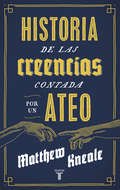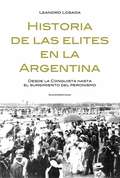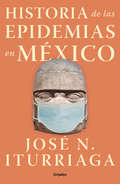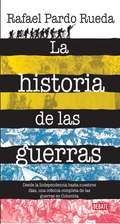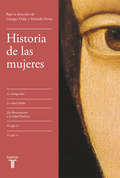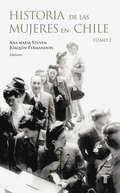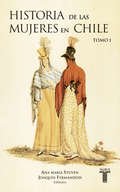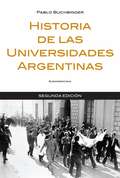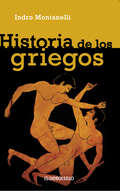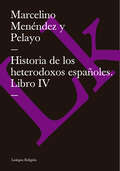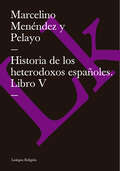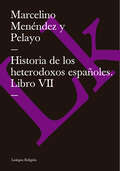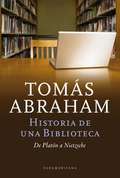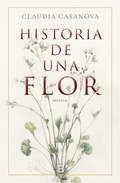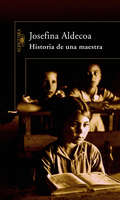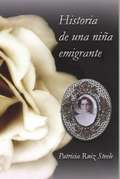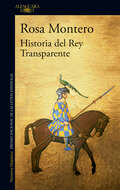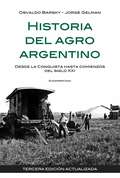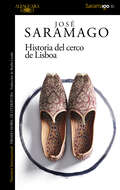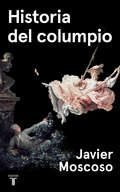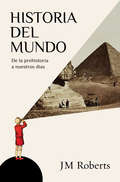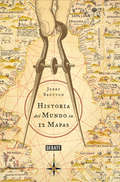- Table View
- List View
Historia de las creencias (contada por un ateo): Cómo comprender nuestro invento más extraordinario
by Matthew Kneale¿Qué fue lo primero que motivó al hombre prehistórico, refugiado en la oscuridad de sus profundas cavernas, a recurrir al reino de los espíritus? ¿Y por qué la fe ha prosperado desde entonces, empujándonos a reflexionar sobre el cielo y el infierno, el pecado y la redención y, sobre todo, los dioses? La religión refleja nuestras más altas esperanzas y nuestros peores temores. Y tanto si usted es creyente como si, al igual que Matthew Kneale, posee la perspectiva de un no creyente que admira la capacidad del hombre para crear e imaginar, no cabe duda de que ha dado forma al mundo en que vivimos. A medida que han cambiado nuestros sueños y pesadillas también lo han hecho nuestras creencias. De los chamanes a los sacerdotes aztecas, de los budistas a los cristianos, los dioses que creamos han evolucionado y mutado con nosotros. La fe ha sido la más épica labor de invención del hombre. Se ha convertido en nuestra más íntima compañera y ha seguido a la humanidad a lo largo de los continentes y a través de las épocas. Esta es su historia.
Historia de las elites en la Argentina: Desde la conquista hasta el surgimiento del Peronismo
by Leandro LosadaUn análisis de largo plazo y en perspectiva de los grupos y círculos queejercieron el poder político, condujeron la economía, perfilaron lasideas de una época en la Argentina. Ciertas miradas convencionales frecuentemente han señalado a las «clasesdominantes» o a los «sectores dirigentes» como los principalesresponsables de muchos de los problemas que atravesaron a los argentinosa lo largo de su historia.En este libro se ofrece un análisis de largo plazo y en perspectiva dela historia de las elites en la Argentina a partir de una serie detemas: su composición social; los atributos que cimentaron el poder, lariqueza y el status en diferentes contextos históricos; las prácticassociales y las identidades. La exploración, sostenida en los principaleslineamientos ofrecidos por la historiografía más rigurosa, se extiendedesde el período colonial hasta el surgimiento del peronismo. De estamanera, desfilan por estas páginas, entre otras, las modestas elites dela temprana Buenos Aires de los siglos XVI y XVII; las más opulentas delInterior colonial; las incipientes elites políticas e intelectualessurgidas con la Revolución de Mayo de 1810; la próspera eliteterrateniente pampeana de fines del ochocientos; y las elites políticasque alentaron o al menos asistieron a la reforma electoral de 1912. Ellibro evalúa, además, cómo mutó el lugar de las elites en la sociedad alo largo de tan extenso arco temporal.
Historia de las epidemias en México
by José N. Iturriaga«La Historia debe ser una lección del pasado para afrontar y orientar el presente e inducir [...] el futuro que deseamos», escribe Iturriaga. Fiel a este precepto, en este libro encontraremos no solo una compilación de las enfermedades más relevantes en México, sino herramientas para abordar nuestro presente y, por tanto, nuestro futuro a medio y largo plazo. Este volumen ofrece un recorrido cronológico por las epidemias que asolaron México desde la época prehispánica hasta nuestros días. Aunque son innumerables las investigaciones acerca de la historia de eventos epidémicos en el país, no existía hasta ahora un volumen compendioso, para un público no especializado y de atractiva lectura sobre la materia. José N. Iturriaga se ha dado a la tarea de estudiar a profundidad las fuentes y traducir toda esa información en un solo tomo dirigido al público general. Desde las conocidas de manera genérica como pestes en el periodo precolonial (cocoliztles, en náhuatl), hasta el cólera morbus, la fiebre amarilla o la influenza española, el autor se detiene brevemente, pero con absoluto rigor, en cada una de estas enfermedades que marcaron a la población mexicana a través de los siglos.
Historia de las guerras
by Rafael Pardo RuedaUn estudio completo sobre las guerras que ha tenido Colombia en toda su historia La guerra ocupa un papel preponderante en la historia humana. Ha sido determinante de tragedias y de cambios en el curso de la historia de civilizaciones enteras. Las guerras no empiezan por casualidad. Ocurren, en general, por profundas razones sociales, políticas o económicas, y usualmente tampoco se acaban solas. Este libro contiene dos partes: la primera recorre la historia de la guerra en Colombia desde la Independencia en el siglo XIX. Las causas de estas guerras y las formas como terminaron, sus más relevantes consecuencias sociales y políticas en la vida nacional. La segunda sección trata sobre la guerra internacional. Enfrentó Colombia no menos de cinco incidentes con Ecuador en el siglo XIX, con Perú tuvimos una guerra cuando formábamos parte de la Gran Colombia y otra en el siglo XX. Finalmente, en 1950 Colombia hizo parte de una fuerza multinacional de Naciones Unidas en Corea. Sin conocer las causas de la guerra en Colombia, su desarrollo y su evolución, es casi imposible construir una paz estable y duradera. Por esto, tal vez el mejor aporte a la paz es estudiar la guerra, o las guerras, que hemos tenido, para así sacar conclusiones y planificar su final.
Historia de las mujeres (edición estuche): La Antigüedad | La Edad Media | Del Renacimiento a la Edad Moderna | El siglo XIX | El siglo XX
by Georges Duby Michele PerrotLos cinco tomos de la obra pionera que supo responder a la necesidad de darles a las mujeres un espacio propio en la Historia, por los prestigiosos historiadores Georges Duby y Michelle Perrot, en una magnífica edición estuche. La AntigüedadLa Edad MediaDel Renacimiento a la Edad ModernaEl siglo XIXEl siglo XX Esta Historia de las mujeres responde a la necesidad de ceder la palabra a las mujeres. Alejadas, desde la Antigüedad, del escenario donde se enfrentan a los dueños del destino, reconstruir su historia significa describir su lento acceso a los medios de expresión y su conversión en persona que asume un papel protagonista. Este análisis implica, asimismo, que las relaciones entre los sexos condicionan los acontecimientos, o la evolución de las sociedades. No se buscan conclusiones tajantes sino que las mujeres encuentren, al fin, su espacio propio. Esta obra busca analizar cómo las relaciones de los sexos condicionan la evolución de las sociedades y la necesidad de que las mujeres encuentren, al fin, su espacio propio.
Historia de las mujeres en Chile. Tomo 2: Tomo 2
by Ana María StuvenUn estudio de époco fascinante, riguroso y muy bien documentado El siglo XX podría ser considerado el «siglo de la mujer», dado el rol público que logró al emanciparse de la tutela masculina e integrarse al mundo laboral y político, aseveran los editores de este segundo volumen de Historia de las mujeres en Chile. En él se abordan aspectos de la larga lucha femenina, que ha tenido como resultado una creciente, aunque aún incompleta, igualdad social para las mujeres. Los autores de los ensayos incluidos en este tomo muestran, entre otros temas, cómo a partir de un feminismo conservador, inserto en la pugna entre clericalismo y anticlericalismo, emergió una problemática femenina más compleja, que incorporaba su pleno derecho de participación en la esfera pública. También se expone el desafío de las mujeres artistas, su consolidación profesional en el ámbito de la salud, las diversas condiciones de vida y trabajo de la mujer del campo, las circunstancias de las prostitutas desde la perspectiva de las propias trabajadoras sexuales, y un análisis de la mujer machi como personificación de la tradición y desafío a las normas convencionales de género.
Historia de las mujeres en Chile. Tomo I: Tomo I
by Ana María Stuven Joaquín FermandoisLa mujer ha sido invisibilizada por la historia. No porque haya estado ausente de ella, sino porque la miradas pública y de la historiografía la recluían al mundo de lo privado. "La mujer ha sido invisibilizada por la historia. No porque haya estadoausente de ella, sino porque la miradas pública y de la historiografíala recluían al mundo de lo privado. El proceso de transformación de lasrelaciones humanas y la democratización social de los últimos dossiglos, aunque aún incompletos, han implicado la incorporación dediferentes actores excluidos históricamente del quehacer público. Entreellos, la mujer ha logrado un reconocimiento a su rol protagónico y a sucapacidad de intervención más allá del ámbito privado.Este primer volumen de Historia de las mujeres en Chile se inicia con lallegada de los conquistadores y cierra en el siglo XIX. Estos artículosabordan la presencia femenina durante la Conquista, el aporte de lasindígenas, la situación de las solteras y viudas, su rol en la Guerradel Pacífico, la contribución de las congregaciones religiosas y suaporte a la educación nacional."
Historia de las palabras
by Daniel BalmacedaCada palabra tiene su origen en una anécdota que sorprende por simple ydesopilante. Daniel Balmaceda ha unido en este libro sus dos pasiones: la historia yla palabra. ¿De dónde surgieron términos como "abatatarse" o"boicotear"? ¿Por qué le decimos cubiertos a los utensilios que usamospara comer? ¿Por qué conocemos como jacuzzis a las bañeras conhidromasaje? La historia de las palabras es la historia de nuestrapropia vida. Por eso, las palabras son muy valiosas. Si queremos sacarprovecho de ellas, debemos conocerlas mejor.En esta oportunidad, Balmaceda no recorre la atormentada vida de ManuelBelgrano, los actos heroicos en nuestras batallas, el romance oculto deVictoria Ocampo o las aventuras inigualables de algunos granaderos. Aquílas protagonistas son las palabras que usamos todos los días. Detrás decada una hay tragedia, romance y comedia. Nada mejor, entonces, quesumergirnos en las emocionantes aventuras de nuestras compañeras desiempre.
Historia de las religiones en la Argentina: Las minorías religiosas
by Susana BianchiEste libro intenta construir una síntesis que permita alcanzar unavisión más amplia del panorama religioso argentino, que incluya lasminorías. En la Argentina, la identificación entre catolicismo y nacionalidad, quecomenzó a gestarse desde las últimas décadas del siglo XIX y que culminóen el «mito de la nación católica», ha excedido los discursos militantespara alcanzar el sentido común: ser argentino es ser católico. Estelibro trata precisamente sobre los «otros»: protestantes, judíos,musulmanes, ortodoxos. Esos «otros» constituyen un sujeto fragmentado,un conglomerado muy diverso de creencias y cosmovisiones. ¿Qué losunifica? Los unifica, básicamente, la mirada que aspiró «y aspira» a laconstrucción hegemónica del catolicismo como fundamento de la sociedad.Los «otros» son los que, desde esas ilusiones y desde esas miradas,parecen no tener cabida. Sin embargo, ellos están y son parteconstitutiva del cuerpo social. Son, sin duda, minoritarios pero supresencia, que aportó una notable diversificación, fue decisiva para laconstrucción de un campo religioso autónomo en un camino que es posibleidentificar con el de la secularización y la formación de una Argentinaplural.
Historia de las universidades Argentinas
by Pablo BuchbinderEste trabajo aspira a llenar un vacío en la historiografía argentinacontemporánea, motivado por la ausencia de una síntesis integral de lacompleja evolución de las instituciones universitarias y su papel en lapolítica, la sociedad y la cultura local. El libro aborda la historia de las universidades argentinas, desde lafundación de la casa de altos estudios de Córdoba a principios del sigloXVII hasta las reformas académicas de la década de 1990. Adopta unenfoque que privilegia la inserción de esta historia en los procesos másamplios de evolución de la vida cultural y política rioplatense, luegoargentina, procurando no limitarse a una historia auto centrada en laspropias instituciones. Las universidades constituyeron el principalespacio de formación de los profesionales liberales, conformaron ellugar por excelencia de socialización de las elites políticas y seconvirtieron también en una instancia central para el ascenso social degran parte de los hijos de inmigrantes que llegaron en forma masiva a laArgentina a finales del siglo XIX y principios del XX. Estas variablesson objeto de análisis en la presente obra. Pero también se explora elpapel activo que los universitarios desempeñaron en los complejosprocesos políticos y sociales de la Argentina contemporánea.
Historia de los griegos
by Indro MontanelliHistoria de los griegos constituye una obra inteligente y rigurosa que devuelve la condición de seres de carne y hueso a los grandes personajes de la cultura griega. Indro Montanelli, reconocido especialista en el tema, ofrece una visión casi periodística de la vida política y sociocultural del mundo griego, y permite conocer una serie de hechos y circunstancias hasta ahora mantenidas en segundo plano por la Historia tradicional. Montanelli convierte a Homero, Sócrates, Pitágoras, Pericles y otros muchos personajes históricos helenos en protagonistas de una narración apasionante que lleva al lector de viaje al nacimiento de las grandes disciplinas artísticas y humanísticas de la civilización occidental, así como de los grandes mitos que todavía hoy siguen siendo el referente de nuestra cultura. A caballo entre la narración y un riguroso libro de historia, esta obra -igual que su predecesora, Historia de Roma- es un auténtico referente para varias generaciones de lectores que, a través de sus páginas, descubrieron la vida cotidiana de los hombres que forjaron nuestra civilización. «He llamado a este libro Historia de los griegos, porque ésta es una historia de hombres, y no tanto una historia de un pueblo, de una nación o de un estado.»Indro Montanelli
Historia de los heterodoxos españoles. Libro IV
by Marcelino Menéndez y PelayoThe author wrote in this piece concerning the role of the historian, who must also be a theologian, and discussed the difficulties and frustrations of chornicling an ongoing field like historical study. It is a scholarly work of great significance to conservative thought in 20th century Spanish society.
Historia de los heterodoxos españoles. Libro V
by Marcelino Menéndez y PelayoThe author wrote in this piece concerning the role of the historian, who must also be a theologian, and discussed the difficulties and frustrations of chornicling an ongoing field like historical study. It is a scholarly work of great significance to conservative thought in 20th century Spanish society.
Historia de los heterodoxos españoles. Libro VII
by Marcelino Menéndez y PelayoThe author wrote in this piece concerning the role of the historian, who must also be a theologian, and discussed the difficulties and frustrations of chornicling an ongoing field like historical study. It is a scholarly work of great significance to conservative thought in 20th century Spanish society.
Historia de un biblioteca: De Platón a Nietzsche
by Tomás AbrahamAbraham nos permite seguir el curso de la filosofía occidental yencontrar los nudos de su articulación en los lugares menos pensados. Este libro evoca una historia personal y construye un programa irresistible y exclusivo. Las respuestas habituales se borran, abolidas por un rigor asistemático que no asigna valores juzgados desde algún tribunal sino que contrasta usos, pasiones y texturas. En pocos textos como en este de Abraham la idea de libro se consolida con la de biblioteca y cultura. Dentro de cada uno de estos conceptos una sustancia única y renovada nos permite seguir el curso de la filosofía occidental y encontrar los nudos de su articulación en los lugares menos pensados. A partir de esos hallazgos, esta «historia universal de una sola biblioteca» nos ayuda a habitar la filosofía desde la sorpresa y admiración que prodiga el autor a los responsables de su vocación.
Historia de una flor
by Claudia CasanovaClaudia Casanova despliega en su nueva novela la hermosa sencillez de una historia narrada con exquisita sensibilidad. Elegante y sutil, emocionará a los lectores con la fuerza y delicadeza de obras como Seda o La joven de la perla. La auténtica belleza reside siempre en los detalles. En el brillo de una gota de rocío, en la mirada curiosa de una joven, o en los pétalos de una flor sin nombre. Alba, curiosa e inteligente, pasa las horas recorriendo el valle con su colección de flores, que cataloga con minuciosidad. Su hermana la acompaña siempre, en busca, a su vez, de los ejemplares de insectos más bellos y sorprendentes. Hasta el pequeño pueblo en el que su acomodada familia pasa los veranos llega un día Heinrich Wilkomm, un renombrado botánico centroeuropeo. La pasión por la ciencia que comparte con Alba pronto evolucionará hacia algo más prohibido, secreto e inolvidable que, como la flor que ambos nombran por primera vez, tendrá raíces tan profundas que será capaz de crecer entre las piedras.
Historia de una maestra (Narrativas Hispánicas Ser. #Vol. 97)
by Josefina AldecoaUna narración hecha desde el recuerdo, llena de verdad y de sentimientos auténticos. En 1923 Gabriela recoge su título de maestra. Es el comienzo de un sueño que la llevará a trabajar en varias escuelas rurales en España y en Guinea Ecuatorial. Historia de una maestra es la narración, hecha desde la memoria, de la vida de Gabriela durante los años veinte y hasta el comienzo de la guerra civil. Con el trasfondo de la República, la revolución de Octubre y la guerra, esta novela rememora aquella época de pobreza, ignorancia y opresión, y muestra el importante papel de la enseñanza y de aquellos que lucharon por educar un país. Contada desde la verdad del recuerdo, con sentimientos que apenas nos atrevemos a reconocer y desde una progresiva toma de conciencia, Josefina Aldecoa nos abre un camino a la esperanza y al idealismo.
Historia de una niña emigrante
by Patricia Ruiz Steele Consuelo MelladoCorría el año 1911 cuando abandonaron todo lo que conocían -- incluso a muchas de las personas que amaban-- para comenzar una nueva vida en un lugar lejano llamado Hawái y después en Estados Unidos. El relato de su emigración es épico y está repleto de tragedias, triunfos, adversidades y amor, de pérdidas y promesas. Estudiar historia de España y diversas fuentes de información sobre inmigración ha contribuido a dibujar un retrato bastante exacto de las personas que emigraron y de las nuevas vidas que comenzaron allí. Esta es la historia de su emigración. Manuela, la primogénita de una familia de campesinos de Fuentesaúco, un pueblo de la provincia de Zamora, en el norte de España, llega hasta La Línea y al Peñón de Gibraltar para embarcar en el S. S. Orteric con sus padres, tíos y primos. Tan excitada como asustada, espera con ilusión afrontar la aventura del viaje y conocer Hawái y, más adelante, Estados Unidos, la tierra prometida. A pesar de la pena de alejarse de su abuela, se adapta a la vida en el barco, pero llega a desear no haber embarcado jamás. A medida que se desarrollan los acontecimientos, vemos cómo estos influyen en sus pensamientos, en su temprana madurez y en su futuro. Esta es la historia de la abuela de la autora, que narra sus vivencias en España y en Hawái. Es una narración conmovedora sobre la importancia de la familia y sobre los lazos culturales y los valores del viejo mundo que supieron fusionar con los del nuevo mundo para alcanzar el prometido sueño americano.
Historia del Rey Transparente
by Rosa MonteroSiente el corazón que late bajo la piel de hierro.Un insólito y original viaje a la edad media. PREMIO NACIONAL DE LAS LETRAS 2017 En un turbulento siglo XII, Leola, campesina adolescente, desnuda a un guerrero muerto en un campo de batalla y se viste con sus ropas de hierro, para protegerse bajo un disfraz viril. Así comienza el vertiginoso y emocionante relato de su vida, una peripecia existencial que no es solo la de Leola sino también la nuestra, porque esta novela de aventuras con ingredientes fantásticos nos está hablando en realidad del mundo actual y de lo que todos somos. Historia del Rey Transparente es un insólito viaje a una Edad Media desconocida que se huele y se siente sobre la piel, es una fábula que conmueve por su grandeza épica, es uno de esos libros que no se leen, sino que se viven. Original y poderosa, la novela de Rosa Montero tiene esa fuerza desbordante de los libros llamados a convertirse en clásicos. ** Premio Mandarache 2007 ** Premio Leyenda 2019 concedido por la Asociación de Librerías de Madrid
Historia del agro argentino: Desde la conquista hasta comienzos del siglo XXI
by Jorge Gelman Osvaldo BarskyLa primera síntesis de conjunto de la evolución del agro en laArgentina, en todo el territorio y desde la colonia a nuestros días. A pesar de la importancia que tiene el agro en la sociedad argentina,han sido escasos los intentos de indagar en su evolución a lo largo dela historia. Este libro construye una síntesis del desarrollo rural detodo el país: comienza con el análisis de las comunidades indígenas ycontinúa con la construcción del mundo agrícola colonial, laconformación de las nuevas economías agrarias a partir de laindependencia, la expansión ganadera en la primera mitad del siglo XIX yel crecimiento de distintas economías regionales. El estudio avanzasobre el notable desarrollo del agro pampeano y el auge de la producciónazucarera del noroeste y vitivinícola de Cuyo, así como las de otrassociedades del interior. Asimismo, son analizados los efectos de laPrimera Guerra Mundial y de la crisis internacional de los años 30 enlas políticas y las dinámicas agrarias. La caída de la producciónagrícola pampeana y los cambios sociales desatados en esta región en elcontexto de la Segunda Guerra Mundial, y el posterior período derecuperación, junto a los avances de las producciones regionales sepresentan detalladamente. Finalmente, el impacto de las medidasmacroeconómicas en la reorganización del ámbito rural en las últimasdécadas, incluido el conflicto por el excedente agrario que sacudió alpaís en 2008, cierra este libro en el que los autores ofrecen una visióncompleta y profunda de un sector decisivo en el pasado y presente de laArgentina.
Historia del año 1883
by Emilio Castelar y RipollThe First International was held in London in 1864 during which the European working class discussed its emancipation from the capital. The First Congress of the Spanish Section of the Internacional was held in 1870 and later, in 1883 a commission was formed to study the social problems created by the government.
Historia del cerco de Lisboa
by José SaramagoUna novela contemporánea en la que caen varios cercos: el histórico de la ciudad de Lisboa, el que impide al hombre comunicarse con sus semejantes y, finalmente, el de la soledad, definitivamente abatido en el amor realizado. Raimundo Silva es un revisor de textos de una editorial, un personaje anodino que tiene como misión en la vida conservar la integridad de los textos que llegan a sus manos. Un día, revisando un texto histórico, toma una decisión: introducir un «No» donde debiera aparecer un «Sí». Esta determinación altera, sin duda alguna, la historia escrita, pero también va a ser fundamental en su vida personal. El conservador Raimundo Silva no volverá a ser sujeto paciente de la historia, tanto la universal como la personal, porque su acto de rebeldía le hace asumir el protagonismo que, como hombre -y por tanto hegemónico- le corresponde en la vida.
Historia del columpio
by Javier MoscosoLa fascinante historia, alejada del parque infantil, de un artilugio empapado de magia, pasiones, leyendas, ritos, goce, erotismo, diversión o muerte. El columpio ha acompañado a los seres humanos desde la Grecia clásica o la China preimperial. Sus usos han labrado un terreno fecundo entre el arte y la vida, entre el ritual y el conocimiento, entre la cultura y el juego. Javier Moscoso, uno de los ensayistas españoles más originales y prestigiosos, indaga en el placer de la oscilación y en la universalidad de este instrumento, principalmente femenino, a través de sus usos, significados y metáforas, con ecos y maravillosas coincidencias en épocas y lugares remotos: de la escoba de la bruja al yoga aéreo, de la horca a la esta galante. Moscoso explora con brillantez la presencia y el papel del columpio en las obras de Watteau, Fragonard o Goya, entre otros muchos; el movimiento pendular como juego de transposición en el que la mujer adopta la posición dominante; o las asombrosas zonas de confluencia con otras tradiciones culturales, en la India, Corea, Tailandia o China. Relacionado desde la Antigüedad con el sexo y con la muerte, empleado por dioses y por locos, instrumento erótico y terapéutico al mismo tiempo, el columpio es un objeto imprescindible, aunque olvidado, en la historia universal de la experiencia humana.
Historia del mundo
by J. M. RobertsLa magna Historia del mundo de J.M. Roberts es un ejercicio extraordinario de comprensión y síntesis, en el que el prestigioso historiador británico recorre la historia universal en una exhaustiva crónica de la humanidad desde sus orígenes en la sabana africana al mundo surgido de las cenizas de las torres gemelas.Un iluminador relato tejido con maestría y rigor que persigue los principales procesos históricos sin dejar a un lado el arte, las religiones, la economía o los avances científicos para ponerlos en relación y así desvelar el legado que ha sedimentado en la configuración del mundo que vivimos. Con su maestría para la narración histórica, nos cuenta el origen de las civilizaciones en Mesopotamia, el Antiguo Egipto, India, China, África y América del Sur; nos explica el Imperio romano, la explosiva llegada del islam, el auge y caída del dominio samurái en Japón, los reinos medievales del África subsahariana, las conquistas mongolas, la independencia de EEUU, la Revolución francesa, los imperios coloniales, las guerras mundiales o la caída de la URSS. Escrito con vivacidad y firmeza, esta Historia del mundo ofrece la mejor y más legible historia universal, por primera vez en un solo volumen.
Historia del mundo en 12 mapas
by Jerry BrottonUn recorrido por la historia a partir de doce mapas fundamentales Desde la Antigüedad, los mapas han sido fundamentales a la hora de conformar nuestra visión del mundo y nuestro lugar en él. Pero lejos de ser objetos meramente científicos, los mapas del mundo son inevitablemente ideológicos y subjetivos, y están estrechamente relacionados con los sistemas de poder y autoridad de épocas y lugares concretos.En esta estimulante obra, Jerry Brotton examina la importancia de doce mapas, desde las representaciones místicas de la historia antigua hasta las imágenes vía satélite de la actualidad. Al recrear el lugar y las circunstancias en las que se originó cada uno de los mapas, muestra que todos ellos presentan una visión única del mundo, ya sea la perspectiva cristiana del mapa de Hereford datado hacia 1300, con Jerusalén en el centro, o la proyección de Peters de la década de 1970, que intentaba dar mayor relieve "al tercer mundo".Aunque el modo en que representamos nuestro entorno está cambiando de nuevo, Brotton considera que los mapas actuales no son más definitivos ni objetivos que antes: todavía presentan ideas y conceptos, y recrean, configuran y orientan nuestra visión del mundo. Quien lea este libro no volverá a ver un mapa de la misma manera.La crítica ha dicho...«Un viaje espléndido para inteligencias audaces.»Kirkus«Un estimulante e iluminador estudio de cómo la mezcla de ciencia, política e incluso religión influyó, y sigue influyendo, en la cartografía.»Booklist«Esta historia de doce mapas decisivos -incluido el de Google- es una revelación.»Publishers Weekly«Una historia fascinante y amplia de la cartografía. La idea de Brotton de encontrar en los mapas los patrones del pensamiento humano es maravillosa.»Tom Holland, The Guardian«Este libro apasionante y magníficamente ilustrado demuestra que los mapas, desde la Antigüedad, han tenido una fuerte carga simbólica. Una historia magnífica.»Sinclair McKay, The Daily Telegraph«Un logro de la evocación. Un libro deslumbrante y provocador.»Anthony Sattin, The Literary Review«Una lectura apasionante.»Carl Wilkinson, Financial Times«Una historia admirable, que apasionará a cualquier aficionado a la historia y la geografía.»David Wootton, The Times Literary Supplement
